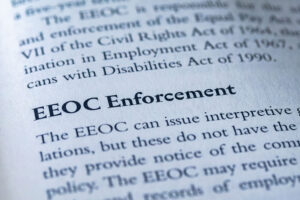An EEOC Right to Sue Letter is a crucial document in employment discrimination cases. It signifies the culmination of the administrative process with the Equal Employment Opportunity Commission (EEOC), granting you the authorization to initiate a lawsuit in federal court. This letter is issued once you have exhausted all administrative remedies for your discrimination claim, essentially passing the baton to you for legal action.
The Significance of the Right to Sue Letter
Receiving this letter from the EEOC is a critical step in the legal journey against workplace discrimination. It indicates that the EEOC has completed its investigation of your discrimination charge and has either opted not to pursue legal action or was unable to resolve the matter. The issuance of this letter is a green light for you to continue your fight for justice in court.
Navigating the Administrative Process
The journey to receiving a Right to Sue Letter begins at your workplace, typically with a report to the human resources department. This step is often mandated in employee contracts and can be pivotal in cases involving harassment by a non-supervisor. By alerting HR, you place your employer on notice, which is crucial if the employer fails to take appropriate action.
If HR’s response is unsatisfactory, the next step is filing a charge of discrimination with the EEOC or your state’s anti-discrimination agency. The EEOC then conducts a thorough investigation, which may involve reviewing documents, interviewing witnesses, and attempting mediation. If these efforts don’t yield a resolution and the EEOC chooses not to litigate, they issue the Right to Sue Letter.
Timeframes for Legal Action
Upon receiving the Right to Sue Letter, you have a 90-day window to file your lawsuit. It’s important to remember that before reaching this stage, you must file your discrimination charge with the EEOC within 180 days of the discriminatory act, or 300 days if you’re also filing a state charge.
Exceptions to the Right to Sue Requirement
Not all discrimination claims necessitate a Right to Sue Letter. Claims under the Equal Pay Act and age discrimination under the Age Discrimination in Employment Act (ADEA) are exceptions. These claims can be directly filed in court, bypassing the EEOC’s administrative remedies.
What Constitutes Workplace Discrimination?
Workplace discrimination involves unequal treatment based on a protected characteristic. Key federal laws like Title VII of the Civil Rights Act, ADA, PDA, EPA, and ADEA protect against discrimination based on race, national origin, gender, sexual orientation, disability, and more. Discrimination manifests as harassment, a hostile work environment, or wrongful termination.
Seeking Legal Assistance
Facing discrimination in the workplace is a serious matter. If you believe you’ve been discriminated against, consulting with an experienced employment attorney, such as those at PLBH, is a wise step. They can guide you through the process of filing your charge with the EEOC or state agency and ensure you adhere to all legal deadlines. With their expertise, you can effectively navigate the complex landscape of employment discrimination law and pursue the justice you deserve.

